
By Independent Team
President Kiir clings on to power in wild-west style
Salva Kiir Mayardit was a teenager when he first joined the fight for the liberation of his homeland in the 1960s. By 1972 he was a low ranking officer when he joined the Sudanese army under a deal between then-Sudan president Jaafar Numeiri and the Anyanya rebels.

Kiir joined the fighting again when, a decade later, the southern rebellion erupted afresh. The fight took a dramatic twist when, Dr John Garang De Mabior, who was a senior commander in the Sudanese army and had been sent to quell the rebellion, joined the rebels instead. In 1984, Kiir was behind Garang in forming the Sudanese Peoples Liberation Movement (SPLM and rose to lead its military wing, the SPLA.
He was Garang’s vice in the SPLM.
After existing in his shadow for decades, Kiir emerged as a leader on the international stage after the Garang died on July 30, 2005.
Although proven on the battlefield and within the inner functioning of the SPLM, Kiir’s ability to lead after Garang’s death was highly doubted by the international community.
Garang had just signed a Comprehensive Peace Agreement with the Khartoum regime and many feared it would either flounder or collapse under Kiir who was believed to hold more hardline secessionist views.
Kiir was also deemed handicapped by his lack of the academic intellectual credentials of either the late Dr Garang or his erstwhile vice president turned nemesis, Dr Riek Machar.
Kiir pleasantly surprised critics when he agreed to replace Garang to the post of First Vice President of Sudan in Khartoum and President of Southern Sudan in Juba as required under the constitution. At the time, he said, his mission was to ensure that the Khartoum regime implemented the terms of the CPA; including the holding of a referendum on self-determination in the south.
Kiir also showed that what he lacked in public performance and oratory, he made up with personal warmth, astute decision-making, and connection to the masses. The euphoria surrounding his commitment to a free and independent South Sudan gave his agenda ballast.
His assertion in 2009 that the choice for the South Sudanese people was to “either be a `second-class’ citizen in Sudan or a `free person’ in your own homeland” endeared him to his countrymen.
He made secession from Sudan for the south his number one priority and in 2010 refused to run for the Sudanese presidency in favour of concentrating on winning the Southern Sudan presidency. He won 93% of the Vote in 2010 and was re-appointed Sudanese First Vice President.
When South Sudan achieved independence in July 2011 and Kiir became the president of the world’s newest country. At the time there were allegations of brutality and vote manipulation but very few people were listening and many did not care.
After about two and a half years in power, Kiir’s unpopularity has emerged as visibly as the cowboy hats he likes to wear, according to some analysts.
They point at the fighting that erupted in December 2013 as a sign of Kiir’s desperate attempt to cling on to power amidst growing opposition within the ruling SPLM. They also accuse him of having an ethnic agenda.
The `committed Christian’ who does not drink or smoke and regularly attends service at the Roman Catholic cathedral in Juba is from the Dinka tribe; the largest in South Sudan. He has been accused of filling most government positions with men and women from his home region of Bahr-el-Ghazal.
On December 6, 2013 some leaders of the SPLM announced that they would be holding a press conference to tell the public about Kiir’s lust for power and refusal to hold the party national convention for fear that he would be ousted from the party leadership. Kiir, on the same day, announced a National Liberation Council meeting which most of his detractors were required to attend.
After a day of what some said was not constructive, about 13 top SPLM members boycotted it on day-three. Kiir had them arrested. On the same day, Kiir appeared on national TV in full army uniform to announce that there had been a coup attempt but it had been crashed.
Soon after, what started as a gun fight that erupted as Kiir’s men attempted to disarm perceived disloyal members of the elite presidential, had escalated into what some fear could become a civil war.
Profile: Salva Kiir Mayardit
1951: Born in North-west South Sudan
1960s: Joined southern rebellion
1983: Founder member of SPLM
1990s: SPLM military leader
2005: Southern leader and national vice-president
2010: Elected president of the region of Southern Sudan
July 9, 2011: Became president of newly independent South Sudan
 The Independent Uganda: You get the Truth we Pay the Price
The Independent Uganda: You get the Truth we Pay the Price


